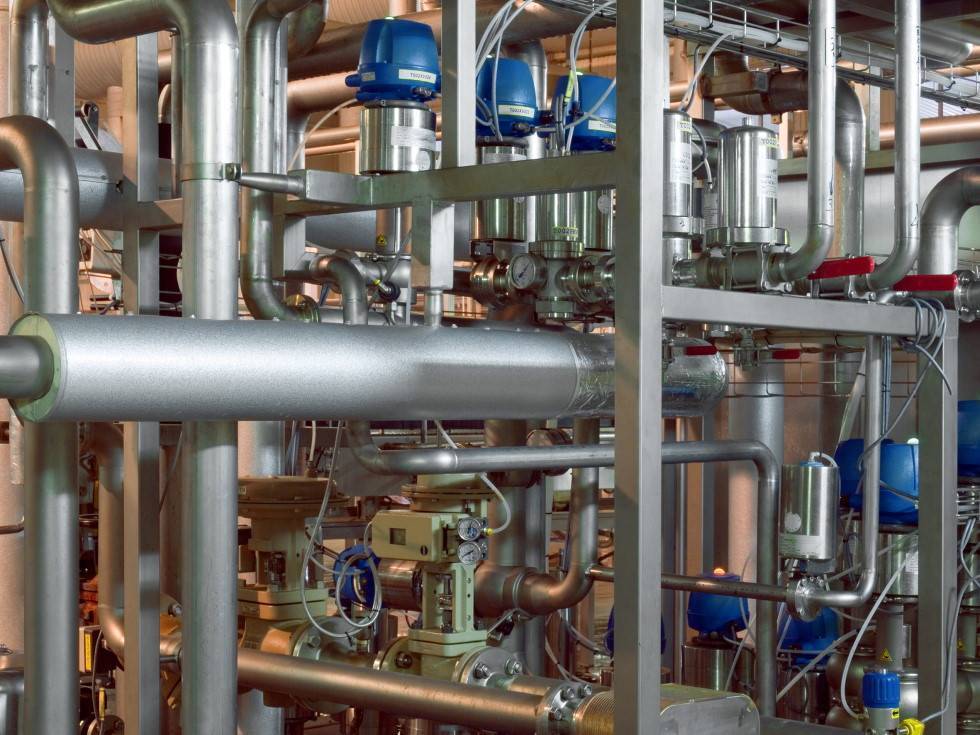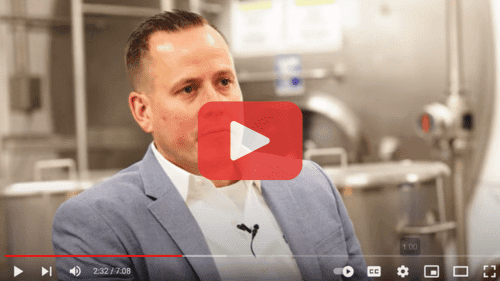Beverage plant sanitation
The beverage industry relies on hygiene, excellent quality, and efficiency.
Effective cleaning is imperative in the Sanitation and Quality Control areas. Your uptime will be greatly improved, cleaning procedures will be carried out faster, and you will avoid contamination.
If executed properly, the processes in the beverage plant will ensure safety, efficacy, and cleanliness.
Sanitation is present throughout the entire process of food processing. Cleaning and CIP procedures play a vital role in the taste and overall quality of the final product. Sanitizing helps to prevent bacterial load in process lines once cleaning is finished. And it is the difference that takes you that extra mile.
In this article, we’ll break down the most important elements you need to know, to effectively sanitize your facility.
Start The Discussion
Meet DeJong
From high-care pharmaceutical, nutraceutical, and biotech to all varieties of human food, dairy, and beverage, DeJong has the experience and knowledge to execute at the highest level in the sanitary space. We’re excited to talk about innovation in the food space with ViewPoint. See Our Interview
Challenges to Beverage Sanitation
The first challenge that threatens hygiene in beverage plants is product contamination.
The presence of bacteria such as E. Coli and Listeria presents a risk to the consumer’s health and your brand’s reputation. The quality of your final product could be affected and this would result in product recalls, lawsuits, or even (in worst-case scenarios) consumer deaths. Aside from the obvious up front cost in lost batches, the brand confidence loss from the public can be fatal to a plant’s continued operations.
Another challenge within companies in the beverage industry is the establishment of ongoing training. In short, teaching employees the procedures that must take place in the plant, as well as communicating the importance of doing so. Cleaning procedure and policy is half of the irreducible minimum when paired with an effectively programmed CIP system.
These challenges can be easily overcome with the right guidance. DeJong Consulting’s extensive experience in the field makes us an ideal solution.


Types of Contamination in Beverage Plants
There are three main types of contamination that occur in beverage plants:
- Cross-contamination: Prone to take place when products manufactured in plants require diverse ingredients. It occurs when employees mishandle ingredients or when the equipment is used in the production of different goods without being cleaned adequately. The most common cause of cross-contamination (and the lion’s share of recalls) is due to cross-contamination that occurs when cleaning one process line while another process line is still running product.
- Microbial contamination: This involves the introduction of bacteria into the product. It usually happens due to the lack of hygienic measures adopted by workers. Like not washing their hands or the absence of protective gear. Due to the rapid spread of harmful bacteria in products, one must be careful to avoid this type of contamination. Since the consumer’s well-being is at stake through foodborne illness. Cleaning fluids or condensate drip from ceilings and mechanical lines can also be primary bacterial load injection points.
- Particle contamination: It takes place when debris or dust infiltrates the beverage during production or the packaging process. This is caused by the lack of sanitizing methods and inadequate air filtration. HVAC plays a huge role in some processes, to the point of dictating the process facility and location in some instances. At a minimum, proper weight has to be given to filtration size and volume of air movement to have an effective particulate minimization outcome.
Best Sanitation Process
The best sanitation procedure is an integrated system that consists of the implementation of these top 7 steps that lead to a cleaner facility. Building systems in each of these areas improve the final product while increasing uptime.
Typically, what we would recommend is a combination of CIP cleaning where possible and COP cleaning wherever CIP is not an option. Clean-In-Place (in short) is using rinses and chemical washes to clean process lines without disassembly and with a minimum of manual intervention. Clean-Out-of-Place is manual disassembly and manual cleaning of process equipment.
In the case of both CIP and COP, it is generally required that hot water, cleaning chemical, rinses, and possibly acid (for sanitizing or for pickling/passivation) are usually employed.
Typically, the equation for effective cleaning includes time, chemical, scrubbing action, and heat.
If you have an abundance of any of the elements available, it will normally reduce the other requirements. As an example, using a very large amount of chemicals (while expensive both in dollars and environmental impact) will likely reduce the time, heat, and scrubbing action required. This tends to be true throughout the equation. Part of our process is to try to find the most efficient mix of elements that takes all environmental, scheduling, and cost factors into account.
On top of that process, ideal equipment sanitation includes:
- Filtration of sanitary water, air, and steam
- Compliance with industry standards
- Scheduled periodic washdowns or CIP cycles
- Routine inspections
- Safety measures to prevent food contamination or staff injury
- Proper training of staff
- Pre Rinse to eliminate soils
- Post-rinse to return process to the food-ready state by eliminating any remaining chemical
- Dry clean processes are much rarer in food and beverage but can be highly effective when needed
- Validation of cleaning process steps
- Proper programming of equipment to allow effective CIP (if applicable)
Clear SOPS & Training
In the food and beverage industry, there are several tasks that need to be executed consistently and repeatedly. That’s where Standard Operating Procedures (SOPs) need to be implemented.
SOPs increase efficiency, giving clear instructions of what needs to be done and saving time while doing it.
SOPs are vital to streamlining sanitization procedures at the plant.
Employees need concise information on the process that needs to be carried out to sanitize the equipment correctly.
On the other hand, training is a core element of the correct conduct of sanitization. Employees should receive appropriate training concerning hygienic measures, food and beverage processing, use of equipment, and safety measures.
Consistent Cleaning Schedule
Establishing a consistent schedule in the beverage processing plants increases efficiency and productivity significantly. And it’s also a part of implementing clear SOPs.
A daily effective cleaning schedule will help regulate the sanitation procedures by ensuring proper cleaning and food safety.
Elements that are included in the schedule are:
- Item to be cleaned.
- The employee in charge of cleaning it.
- Chemical or physical agent to be used.
- Day and time.
- Cleaning validation upon completion
- Sanitization of cleaned system (if applicable)
- Any other relevant information
Automated Clean In Place Systems
These systems clean the equipment that’s used to process beverages. It may include process pipes, mixers, freezers, blenders, and tanks, among other paraphernalia.
The automated CIP systems carry out their function without having to disassemble the process. These systems are a vital component of the sanitation process in beverage plants since they ensure quality and hygiene and they promote efficiency.
CIP Systems usually carry out the cleaning process in 45 stages:
- Pre-rinse
- Caustic wash
- Final rinse
- Sanitizing rinse
The benefits of automated CIP systems are key for uptime and efficiency, for example:
- Human error is greatly minimized due to the automated nature of CIP systems.
- You ensure safety for your employees by reducing direct contact with chemicals and cleaning solutions, as well as dangerous equipment.
- The quality of your cleaning results is consistent, which can help to avoid the occurrence of product recalls, boosting productivity and uptime.
Proper Personal Protective Equipment (PPE) Use
Creating a safe environment for employees at the plant is key to achieve the safest food production possible.
Given that workers are constantly exposed to chemicals and agents, and they have to operate the equipment in the facility, there is a high risk of injury. This may affect the personnel physically or mentally.
A hazard analysis has to be carried out for you to establish preventive measures. This is sometimes referred to as HACCP. And once the hazards are identified, you can significantly minimize risks in the beverage facility.
Food safety practices can prevent hazards at the workplace, decrease time loss, and enhance a safe working environment.
Appropriate Personal Protective Equipment should be cut-resistant, and high-temp resistant and it should prevent employees from making direct contact with liquid solutions, all while maintaining functionality.
We strive to bring creative thinking and cross-industry experience to the table as we work to solve customers’ process and plant operations challenges. There is no challenge too complex for our team to solve and no business too big or small for us to partner with.


Dave Erlebach, Intrinsic Organics
I work with DeJong Consulting because of his industry knowledge, drive and willingness to go the extra mile. Many consultants would prolong the problem to make extra money, but Michael does what it takes to get it done.
E-mail Address:
Phone Number:
Address:
- 228301 County Rd M, Edgar, WI 54426


